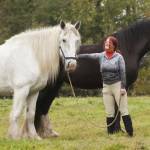Irish Draught Horses and Irish Sport Horses

The word “draught” (British spelling, pronounced “draft”) brings to mind a heavy-bodied workhorse with stout, hairy legs, and a sleepy disposition. In reality, today’s versatile, athletic Irish Draught Horse quickly dispels this mental image. Irish Draughts have achieved top marks as hunters, event horses, jumpers, and dressage mounts in international competition, and crossing them with Thoroughbreds has produced performance horses with exceptional strength, soundness, and temperament.
The origins of the Irish Draught are unknown, but probably include some European warmblood or draft breeds as well as lighter Spanish horses. The Irish Draught was recognized as a unique breed as early as the nineteenth century after the crossing of Connemaras and other native pony mares with Thoroughbred stallions led to a recognizable type. The resulting horses were useful all-around animals that could do farm work, carry their owners in the hunting field, and pull the family wagon to town on market day.
Today’s typical Irish Draught Horse has a body type that more closely resembles a warmblood than a draft horse. Irish Draughts are bred for dense bones and powerful muscles. The neck is strong and slightly crested, the facial profile is straight or slightly convex, the cannon bones are short, and the hooves are strong and well-formed. Most Irish Draughts are bay, chestnut, gray, or brown and may have white markings on the lower legs and face. Mares are typically 15.2 to 16.2 hands, while stallions range from 16 to 17 hands.
Even though they tend to be somewhat more heavily built than Thoroughbreds, Irish Draughts are good movers, easily covering the ground without the ponderous stride of a work animal or the exaggerated knee action of a fine harness horse. Harking back to their Connemara ancestors, many are excellent jumpers.
Irish Draught stallions are often crossed with Thoroughbred mares, and the resulting offspring boast increased size, strength, and muscling as well as an intelligent and sensible temperament. Horses of this breeding are known as Irish Sport Horse. This cross is so popular that, in the middle of the twentieth century, the purebred Irish Draught was in some danger of disappearing because the strongest demand was for the half-bred and many owners neglected to produce replacement breeding stock. The Irish Draught Horse Society was organized in County Cork, Ireland in 1975 with the aim of preserving and promoting the type and bloodlines of the breed. Since then, more than 20 branches of the registry have been established throughout Ireland, and separate registries for Irish Draught Horses and Irish Sport Horses have been formed in the United States, Great Britain, Canada, Australia, and New Zealand. Another group, the Irish Horse Board, promotes horses of Irish breeding, particularly the Irish Sport Horse (sometimes called the Irish half-bred or Irish Hunter). This organization maintains the studbook for the Irish
Sport Horse and also works to support equestrian education and tourism. A host of other societies, registries, and boards have been formed to standardize and support Irish Draught Horses, Irish Sport Horses, Irish Hunters, and other Irish-bred equines. Some, like the Irish Horse Register (IHR), have rigid guidelines for admission, and horses must pass inspection, both in hand and under saddle, to be included.
Depending on the country, organization, and pedigree, some confusion has arisen as to terms used to describe various horses bred in Ireland with or without a measure of Irish Draught blood.
Simple definitions include:
• Irish Draught Horse, a purebred animal
• Registered Irish Draught, an animal passing an approved inspection and approved as RID
• Irish Sport Horse, an animal that usually has Irish Draught genes mixed with other blood (possibly of several breeds), also known as Sport Horse, Irish Hunter, Hunter
• Irish Draught Sport Horse, an animal of Irish Draught and other blood (this category and definition are found only in American and Canadian terminology)
Many of the top-level horses in national and international competition owe their superior strength and athleticism to Irish Draught Horse or Irish Sport Horse breeding. In eventing circles, outstanding names are Custom Made (numerous top finishes at Rolex, Badminton, Olympic Games), Ringwood Cockatoo (good performances at Punchestown and Badminton helped his German rider, Bettina Hoy, to a first-place FEI ranking), and Australian horse Barastoc Tullamore (fourth-place finisher at the Adelaide International four-star event).
Show-jumping stars of Irish breeding include Liscalgot (ridden by Dermott Lennon to the individual championship at the 2002 World Equestrian Games), Carling King (member of Ireland’s Nations Cup teams in 2001, and eighth at World Equestrian Games), and the late King of Diamonds (sire of show jumpers Mill Pearl, Special Envoy, and Millstreet Ruby).
Numbers of top hunters and dressage horses also claim Irish Draught blood in their backgrounds, as do countless pleasure horses and children’s mounts. Some breeders suggest that the most important attribute of the Irish Draught is not its versatility as a performance horse, but its ability to improve other breeds, lending size, strength, soundness, and a sensible mind to many crossbreds.
With their somewhat heavy build, Irish Draught Horses tend to be easy keepers. While they need the same basic supplies of protein, vitamins, and minerals required by all horses, Irish Draughts may be able to maintain weight and condition with fewer calories than would be thought necessary for their size and build. Irish Sport Horses, with their somewhat lighter build and Thoroughbred metabolism, may need a higher-energy feed to meet the demands of training and competition. As with any horse, high-quality hay should form the basis of the feeding program, with concentrates and nutritional supplements being added to meet each individual horse’s requirements.








